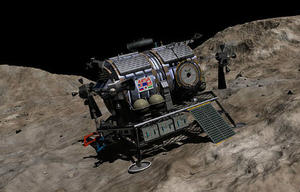Planetary securityThe infrastructure of asteroid-mining economy
An asteroid-mining space economy would be easier to build if there were the equivalent of a few Stuckey’s around out there. As is the case with other enterprises, a space economy will need fuel, liquids, and supplies, and these could be stored in outposts on dwarf planets like Ceres.

The mineral recovery potential of asteroid mining is high // Source: uux.cn
Grant Bergstue and Luke Burgess figure an asteroid mining space economy would be easier to build if there were the equivalent of a few Stuckey’s around out there.
The two graduate students in the Laser Science and Engineering Group (LSEG) at the University of Alabama in Huntsville say the day will come when a space economy will need outposts on dwarf planets like Ceres to provide fuel, liquids, and supplies.
Like Stuckey’s, the business of these outposts will be collecting energy in a centralized place for distribution, and like sodas and Slim Jims in convenience store aisles, water and sundries will also be there for the space traveler.
It is the infrastructure which will be needed to collect and distribute that energy that intrigues the pair.
“A lot of our research is on establishing some sort of energy infrastructure in space, because if you are going to work in space, you will need energy there,” Burgess said. They see lasers as the only feasible space energy pipelines, and have written papers on what an efficient laser distribution system would look like and on using laser energy for propulsion and mining activities.
A University of Alabama in Huntsville release reports that recent LSEG papers include Institute of Electrical and Electronics Engineers (IEEE) publications “Planetary Defense and an Energy Infrastructure for Near Earth Space” (vol. 99, no. 3 [March 2011]) and “Quantum Energy for Space” (vol. 99, no. 11 [November 2011]), as well as International Astronautical Congress (IAC) publications “Energy Support for Missions in Near Earth Space” (IAC-2011-D5.1.1), “Beamed Energy for Ablative Propulsion in Near Earth Space” (IAC-2011-C4.8.2), and “Advancing the Beamed Energy Ablation Driven Propulsion Engine Concept” (IAC-2012-C4.6.6).
Under the guidance of Dr. Richard Fork, Electrical and Computer Engineering professor, the team works like this: Bergstue is the optics man and Burgess is the electronics guy. Burgess is researching how best to transmit short focused laser pulses while Bergstue investigates how best to make such a system safe.
Laser energy transfer in space is not subject to Earth’s limitations. Like fog in a flashlight beam, Earth’s atmosphere disperses the laser and the pulse collapses on itself due to air molecules. In space, lasers have a clear shot.
“Laser based energy goes a lot farther in space than on Earth,” Bergstue said. “There’s no distortion. A lot of my research has been on how to do it safely.” Less distortion means a more concentrated pulse.
“In space,
